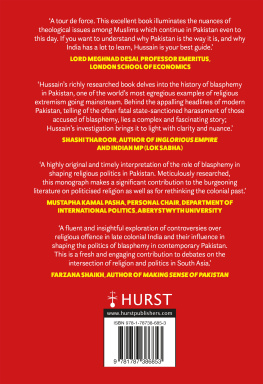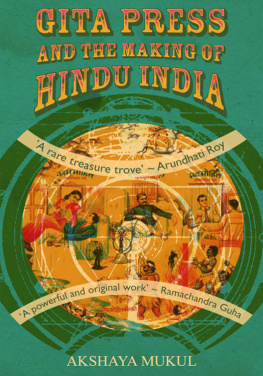ROUTLEDGE LIBRARY EDITIONS: BRITISH IN INDIA
Volume 19
Prophet of a New Hindu Age
First published in 1985 by George Allen & Unwin (Publishers) Ltd
This edition first published in 2017
by Routledge
2 Park Square, Milton Park, Abingdon, Oxon OX14 4RN
and by Routledge
711 Third Avenue, New York, NY 10017
Routledge is an imprint of the Taylor & Francis Group, an informa business
1985 Ninian Smart and Swami Purnananda
All rights reserved. No part of this book may be reprinted or reproduced or utilised in any form or by any electronic, mechanical, or other means, now known or hereafter invented, including photocopying and recording, or in any information storage or retrieval system, without permission in writing from the publishers.
Trademark notice: Product or corporate names may be trademarks or registered trademarks, and are used only for identification and explanation without intent to infringe.
British Library Cataloguing in Publication Data
A catalogue record for this book is available from the British Library
ISBN: 978-1-138-22929-7 (Set)
ISBN: 978-1-315-20179-5 (Set) (ebk)
ISBN: 978-0-415-34741-9 (Volume 19) (hbk)
ISBN: 978-1-138-63345-2 (Volume 19) (pbk)
ISBN: 978-1-315-20756-8 (Volume 19) (ebk)
Publishers Note
The publisher has gone to great lengths to ensure the quality of this reprint but points out that some imperfections in the original copies may be apparent.
Disclaimer
The publisher has made every effort to trace copyright holders and would welcome correspondence from those they have been unable to trace.
Prophet of a New Hindu Age
The Life and Times of Acharya Pranavananda
NINIAN SMART and SWAMI PURNANANDA
London
GEORGE ALLEN & UNWIN
Boston Sydney
Copyright 1985
Ninian Smart and Swami Purnananda
This book is copyright under the Berne Convention. No reproduction without permission. All rights reserved.
George Allen & Unwin (Publishers) Ltd,
40 Museum Street, London WC1A 1LU, UK
George Allen & Unwin (Publishers) Ltd,
Park Lane, Hemel Hempstead, Herts HP2 4TE, UK
Allen & Unwin Inc.,
Fifty Cross Street, Winchester, Mass 01890, USA
George Allen & Unwin Australia Pty Ltd,
8 Napier Street, North Sydney, NSW 2060, Australia
George Allen & Unwin with the Port Nicholson Press
PO Box 11-838 Wellington, New Zealand
First published in 1985
ISBN 0 04 922032 2 cased
0 04 922033 0
Set in 11 on 13 point Imprint by Phoenix Photosetting Ltd, Chatham and printed in Great Britain by Mackays of Chatham Ltd
This book is an account of the life of the remarkable Bengali spiritual and practical leader, Swami Pranavananda, who lived in the first half of the twentieth century. He was only 44 when he died but he left his imprint on India in various ways. He was born in what is now Bangladesh and strove to realise, in the order he founded (his Sangha), an organisation which would bring new energy, life and pride to the Hindu masses of India. As will be seen from the narrative, his work and ideals went well beyond this. He was one of the figures whom we ought to take seriously in estimating the power and value of the modern Hindu renaissance, stretching from Ram Mohan Roy to contemporary times when a variety of new religious leaders have made their impact upon both the Indian and the Western scene. His type of spirituality is very different in certain ways from that of other gurus and saints whose lives have come to the attention of the English-reading public. In some ways he stands most authentically for ancient Hindu values which can easily be overlooked by modern commentators, scholars and interpreters of religion. Perhaps he is the most conspicuous case of the practice of tapasya in modern times. It will be seen from this book how remarkable his self-discipline and self-training were. Quite apart from this, his achievements were such that his life deserves to be better known than it is to the wider world.
Some years ago I was approached by Swami Purnananda (a direct and close disciple of the Acharya for sixteen years) of the London Branch of the Bharat Sevashram Sangha with a view to our working together to bring out a book about Swami Pranavananda. The book has taken its present shape in the following way. Swami Purnananda gave me a copy of a manuscript he had been working on outlining the life and teachings of the Acharya (as our subject was also called). I took this material and used it as a general basis for writing an account. I also made use of some other material, including the biography (rather brief but quite useful) by Swami Veda-nanda. I have written the book in a way which is intended to bring out the Hindu background and to some extent the political background of the Acharyas activities. I have concentrated mainly on giving a sense of the actual fabric of the Hinduism in which the Acharya was himself so important a strand. In this way the book may have a more general interest, for it is itself an introduction to many of the main features of the Hindu way of life. As Hinduism serves, so to speak, as a window on the Acharya so this life of the Acharya may serve as a window on Hinduism. Many readers may find that their views of the Hindu tradition alter somewhat when seen from this particular angle.
It is to be hoped that this account of the Acharya may stimulate others to go further. But the necessities of human existence dictate that most of those who worked with the Acharya up to his death in 1941 have either passed from the scene or may not have too long to live, and so it was important to record something of his life a little more fully than has been done hitherto while still there remains an immediate link with him. There is further research to be done, too, in the newspapers and archives of the period. Substantially this biography is a supplemented version of the memoirs put together by Swami Purnananda.
It should be borne in mind that the book aims to be faithful to two principles. On the one hand it is important as far as possible to present the historical facts about the Acharyas life and activities; but at the same time it is vital for us to glimpse something of his person as seen through the eyes of those who had faith in him and followed him in his arduous calling. I have tried in this latter respect to be what is sometimes called phenomenological; or to put it more simply to see the Acharya through the eyes of those for whom he was a divinely-inspired leader. On the whole I have not otherwise given an evaluation of him, save that in the last chapter there are reflections upon his significance for modern India and in the wider perspective of religion. I have tried to let the meaning of the extraordinary events of his life shine through as they would be perceived not just by the English-speaking, Western reader but also by the monks and masses for whom he was a heroic figure. Never judge a person until you have walked a mile in his moccasins, as the proverb says. So I have, I hope, provided an empathetic account both of his life and of the Hindu environment in which he lived.










